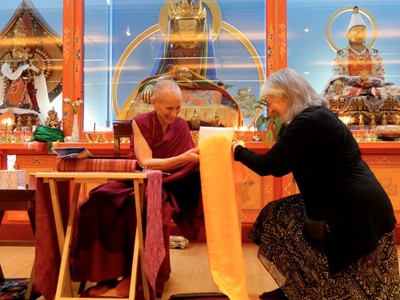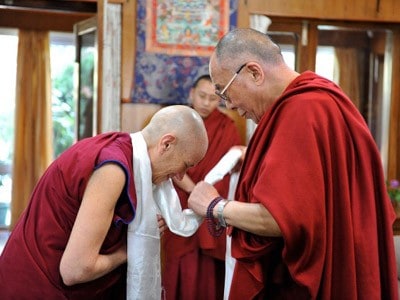Right livelihood for the sangha in the 21st century
Right livelihood for the sangha in the 21st century

As living beings, we monastics are faced with the task of sustaining our bodies so that our precious human lives can be used to practice the Dharma and progress on the path to awakening. What is right livelihood for monastics? In the Vinaya and the sutras, the Buddha gave much guidance on this topic. For example, we are not to till the land, buy and sell things, or handle money, but to live on offerings that are given to us. In receiving these offerings, we must not have procured them through flattery, hinting, coercion, giving a small gift to get a big one, or hypocritically presenting ourselves as excellent practitioners while in the presence of potential benefactors.
The Buddha set forth this guidance on right livelihood for the sangha in the context of ancient Indian society where the populace respected spiritual practitioners and it was the norm for householders to support wandering contemplatives. As the Buddha’s teachings spread to different locales with their diverse cultures, climates, and political, economic, and social structures, these guidelines were modified to fit new circumstances. While the subsequent generations of monastics did not change the Vinaya—the 500 arhats of the first council rejected that option—the interpretation of some of the precepts and the manner in which some precepts were implemented did change. The sangha communities in each locale did so heeding the Buddha’s advice to act in new situations in accord with what he had prescribed or proscribed in similar situations in the Vinaya.
As a result, the main principles of the Vinaya remain intact today and, in general, the worldwide monastics live in similar ways. Nevertheless, differences exist as each Buddhist tradition has its own way of interpreting and adapting the guidelines for right livelihood, and within each tradition, each country, and each particular monastery there are some unique customs and policies. From one perspective, we must trust the motives and decisions each tradition, country, or monastery makes in its adaptation process. All Buddhists love the Dharma and are doing their best to practice and preserve it. From another perspective, reviewing previous decisions and asking questions prevents us from becoming complacent or smug.
Monastic values for right livelihood
What are our common values as Buddhist monastics to employ in 21st century right livelihood?
- Simplicity in terms of number and quality of possessions
- Not living more comfortably than the lay followers who support us
- Following the Vinaya as closely as we are able
- Not inconveniencing lay followers
- Living ethically
- Being an inspiration to society
- Equity in use of resources
To put these in another way, they become the ten advantages for establishing precepts that the Buddha taught:
-
- To direct the monastics
- To make monastics peaceful and happy
- To protect monastics
These three function to promote harmony in the sangha.
-
- To inspire those without faith
- To advance the practice of those with faith
These two function to transform society.
-
- To restrain the restive
- To stabilize those with a sense of integrity
- To eliminate present defilements
- To prevent defilements from arising in the future
These four function to bring liberation.
In general, the goal of all of the above is for the Buddha Dharma to be forever sustained.
Application of those monastic values
Let’s look at some of the ways these values and principles have been employed. In raising the points below, I am not one to judge what is right and wrong. It is not for any of us to point fingers at others and criticize them for their choices. This is a matter for each of us personally to examine and for our communities to discuss. In addition to the varying circumstances mentioned above, people will come to different conclusions depending on whether they live in a Buddhist or non-Buddhist country, whether their monastery has a small number of monastics or thousands of monastics, whether they are refugees or live in their own country. The examples below are drawn from a variety of Buddhist traditions in Asia and in the West.
Regarding money, some monastics do not touch money; others will touch it but the monastery, not the individual monastics, possesses the money. Some monastics I know have their own money—some of them had to work at a job to earn it because they live in a non- Buddhist country and lay Buddhists in their locale give donations mainly to the well-respected monastics but not to the newly ordained. Of those who have to work at a job to survive, some teach at schools, are chaplains at hospitals, or are psychotherapists. Others work at whatever job they can get. Because they live on their own, they go to stores and buy whatever they like, and can afford.
Regarding food, some monastics go on alms round, others eat food brought to the temple. Some monasteries buy and cook food for the community, while some monastics live on their own, shopping and cooking for themselves.
Some monastics rely on donations and do not pressure their followers to give; others chant at funerals with the expectation of receiving large donations for doing so. Some monasteries own restaurants and hotels which they operate to feed the large number of monastics they have.
Some monastics do not drive, although they will ride in luxury cars driven by wealthy benefactors; other monasteries own community vehicles. Some monastics ride motor bikes, while some monastics who live on their own have their own cars.
The use of information technology
The Buddha did not make specific guidelines for one area of sangha livelihood because it did not exist at his time: information technology. This includes tnternet use, chat rooms, iPods, cell phones, computers, iPads, email, Facebook, blogs, and so forth. Information technology is not good or bad in its own right. It is a tool which may be used in a diversity of ways, depending on our motivation and the method in which we use it.
In my travels, I have observed sangha communities relate to these in very different ways. One monk lived simply and studied the Dharma hard. He did not own a computer, so he began to go to the monastery’s Internet café. There he participated in a chat room where he met a woman from another country, who is now his wife. One group of monks never ate after noon, did not touch money, and carefully sat a distance away from any woman they spoke with. However, when they met after not seeing each other for a while, each pulled out his iPod, Blackberry, or cell phone, and spent several hours comparing the qualities and prices of each one. In some monasteries, most of the monastics were talking on cell phones as they walked around; in another monastery with a large campus, individual monastics had cell phones that they used to coordinate the sangha’s activities. Some monastics have their own Facebook pages which they spend a great deal of time updating, while others do not. Some have a lot of spare time and work on their blogs many hours a day. Some blogs contain good Dharma discussions and useful information, others focus on relationships in and amongst Buddhist groups.
An example
Since Buddhism is now spreading and becoming rooted in the West—the area of the world where I live—I would like to share the decisions we have made at Sravasti Abbey regarding sangha livelihood, and in particular our relationship with technology. In doing so, I will describe some of the choices we have made in our attempt to follow a middle way that enables us to abide by the Buddha’s fundamental principles regarding sangha livelihood as well as to be practical regarding the circumstances in which we live in— a conservative, rural area in a non-Buddhist country.
Just before receiving ordination, monastics mentally cease ownership of their money and give it to others. Practically, they may have private funds, but they may only use them for specific purposes: medical and dental expenses (unless they do not have the funds for these, in which case the Abbey covers them), travel for teachings, and making offerings. The Abbey covers health insurance for the fully ordained, study materials, and all other expenses.
Sravasti Abbey monastics do not have their own car. All vehicles belong to the monastery and can be used only with permission. Because we live in a remote area and it would add a great amount of pollution to ask lay followers living in the city to come to the Abbey in order to drive us places, monastics themselves drive. All our trips to town are coordinated to do the maximum number of errands in one trip, and fortunately lay followers who come to the Abbey to offer service for the day help us with this. When traveling to teach the Dharma in the evening, there are at least two monastics of the same sex in the car.
All computers, recorders, iPods, and other equipment for information technology are owned by the community and not by individuals. People are encouraged to use computers in common spaces. Someone else must be in the room when a person is online, and people may be online only to access Dharma information or for Abbey-related purposes. Participation in chat rooms, personal blogs, and personal Facebook pages are not allowed, although there is one Facebook page for the Abbey and the Abbess together that is managed by a lay follower. Personal email use is limited, because we want people to relate to live human beings, not get caught up in a virtual world.
In terms of sharing the Dharma, we use IT a lot: short daily Dharma talks are posted on YouTube, weekly teachings and other longer teachings are archived on BlipTV, and one teaching a week is streamed live over the Internet. We send out a monthly e-newsletter and a monthly short Dharma teaching, and a Dharma education program is available online as well. All of this is provided free. There is no charge whatsoever to access our material online.
Similarly, there is no charge to stay at the Abbey, although we did have to institute a deposit for retreats because sometimes people canceled at the last moment and their place was lost as it was too late to notify someone on the waiting list. We do not buy our own food, but eat only the food that people offer. However, we do cook because we live in a remote area and lay people could not bring cooked food each day. All books and other Dharma materials are freely available, although we do have a dana basket so that people can make offerings. In short, we want our life to be a life of generosity and to encourage generosity in others.
Gender equality
While my topic has been sangha livelihood, and in particular our use of technology, I would also like to briefly mention another area to which the principles spoken of at the beginning of this paper apply. That is gender equality. In modern societies that value gender equality and where laws apply equally to men and women, it is important that the sangha also be gender equal. This can be done without endangering our celibacy precept. If the sangha remains gender biased, many people—both men and women—will lose faith in the Buddha’s teachings, saying, “The Buddha was against the caste system, promoted harmony amongst people, and clearly stated the equality of all sentient beings in having the capacity to awaken. Why is it that the sangha does not live according to these values?” While we may say, “If others leave Buddhism due to this, that is their choice. My responsibility is to do my practice,” or “I wish I could do something, but the Vinaya prohibits making changes,” it would be a terrible loss to all those who could benefit from the Buddha’s precious teachings. In addition, this will eventually affect the livelihood of the sangha, as people will stop supporting what they believe to be an archaic institution.
At Sravasti Abbey we practice gender equality in that all monastics receive the same education, and full ordination as a bhikshu or bhiksuni is available to all. Both men and women spend two years as novices before receiving full ordination, and both women and men give Dharma talks to the sangha and to the lay community. The order for receiving food and other offerings is according to seniority, regardless of gender. Women run chainsaws, men cook and wash dishes, and vice versa.
The relationship of living in community and right livelihood
The Buddha established the sangha as a community for many purposes. Among these are so that:
- monastics will mutually encourage and support each other in keeping the precepts and practicing the path
- society will be inspired by seeing a body of practitioners doing their best to live harmoniously and in accord with the precepts
Nevertheless, each Buddhist tradition has sangha members who live in community and those who live on their own. This may occur for a variety of reasons: lack of support to establish a monastery, lack of a teacher or senior monastic to guide the community, individuals’ reluctance to relinquish their independence, and so forth. However, living on our own presents many dangers to right livelihood. Without the reference point of the sangha, we “interpret” and apply the precepts according to what pleases our self-centered mind and self-grasping ignorance. It is ever-so-tempting to simply do as the lay people surrounding us do, i.e. work at a job, go to the store whenever we wish to buy whatever we wish, have many online friends and go to whatever websites we fancy, and so forth. The unbridled access to material possessions, to information, and to befriending all kinds of people can easily take a monastic down the slippery slope that leads to broken precepts and disrobing.
On the other hand, establishing a healthy community is also full of challenges. Most of us are, after all, unenlightened and prone to afflictions. A community as a whole can be affected by greed or laziness in keeping the precepts, something which is very damaging not only to its individual members but also to society in general. However, since a community is made of many individuals, it is likely that someone will object to practices that lead to degeneration and remind the community of its shared values and principles that come from the Buddha. We have a better chance living with right livelihood if we are surrounded by others who are trying to do the same. It is similar to a sapling trying to grow straight. It will do so when surrounded by older trees and other saplings that are growing upright together. However, a sapling alone—buffeted around by the wind and trampled by those who pass by—will have a hard time growing straight and strong.
The topic of the effect of monastics living in community or living on their own affects right livelihood is a large subject that is best left for another paper. However, we can keep it in the back of our minds and be aware of it as we make choices that affect our values, principles, and life style as monastics.
Conclusion
To conclude, the manner in which the sangha receives its livelihood will have a deep impact on the survival of Buddha Dharma in 21st century society. As the Buddha pointed out, the fading away of the Dharma in the world will come more from internal conditions than from external forces. If the sangha is too “loose” in what it considers right livelihood, monastics’ keeping of the precepts will degenerate and society will lose respect for the sangha. On the other hand, if the sangha is too “rigid” in what it considers right livelihood, society will see it as an archaic institution that is inconvenient to support. Each tradition and each community must find a middle way that works given the particular culture, climate, etc. in which is abides.
The Buddhist sangha now exists in a modern world that differs from the one in which the sangha originated 26 centuries ago. These differences include the widespread use of money rather than a bartering system, information technology, and the values of racial, ethnic, and gender equality and human rights. We must articulate the values and principles from the Buddha that guide our lives and our life style and repeatedly do some introspection, asking ourselves, “How well do I as an individual live in accord with these values? To what extent does my monastery or community live in accord with them? What can we do to increase our integrity with respect to this?” Each of us will reach a different conclusion due to our unique circumstances, but what is important is that we have made our choices after thoughtful consideration and with good reasons. In that way, we will be at peace within ourselves and in our communities, inspire society, and progress on the path to awakening.
This article is available in German: Rechte Lebensweise für die Sangha im 21. Jahrhundert
Venerable Thubten Chodron
Venerable Chodron emphasizes the practical application of Buddha’s teachings in our daily lives and is especially skilled at explaining them in ways easily understood and practiced by Westerners. She is well known for her warm, humorous, and lucid teachings. She was ordained as a Buddhist nun in 1977 by Kyabje Ling Rinpoche in Dharamsala, India, and in 1986 she received bhikshuni (full) ordination in Taiwan. Read her full bio.


